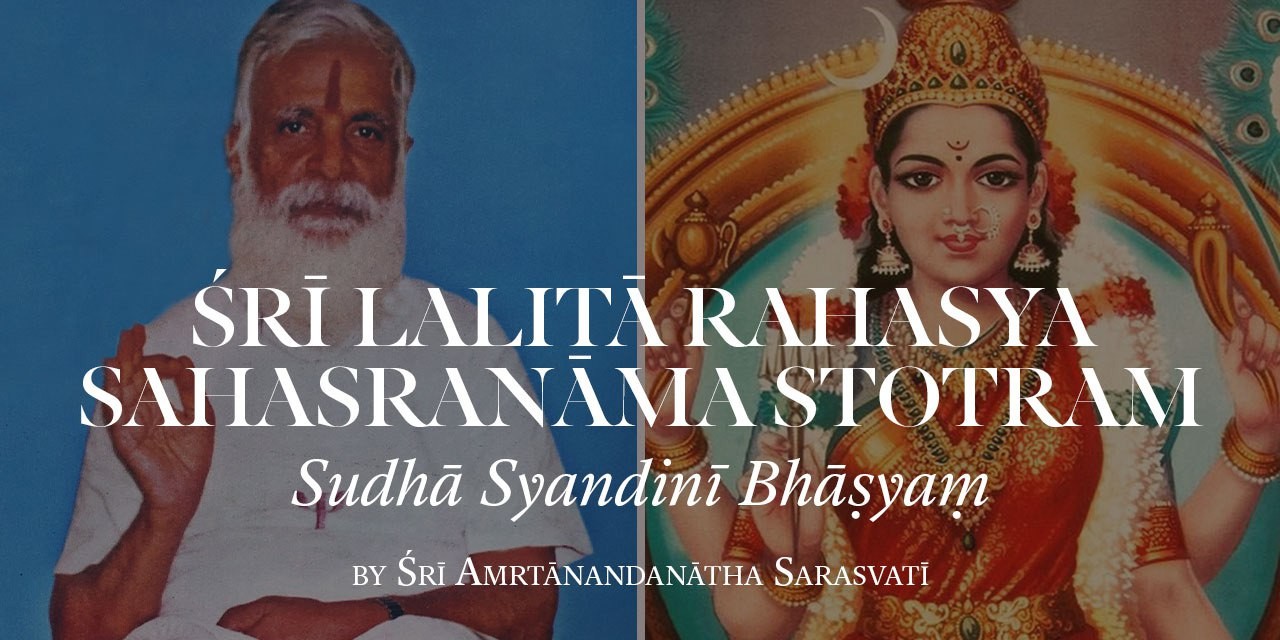
91. Kulasaṅketapālinī
She protects the symbolism of kula. The Āgamas say ‘gomāṁsaṁ bhakṣayen nityaṁ’. This literally means that every day one must eat flesh of cows.
pitvā pītvā punaḥ pitvā papta dharani tale |
utthāya ca punaḥ pītvā śiva sāyujya apuyat ||
This is what Kulārṇava says. This means literally one must drink again and again till one falls down on earth rising up, drink again. Thus you will attain identity with Śiva.
'Ganga, Yamunayoḥ Madhya, Balaredaam, Saraswatīm, Balatkaranagrihiyat, devi sāyujya siddayah’. [most likely it's a reference to Haṭha Yoga Pradīpikā (v. 109): gaṅgāyamunayor madhye bālaraṇḍāṁ tapasvinīm balātkāreṇa gṛhṇīyāt tad viṣṇoḥ paramaṁ padam]
This literally means that between the rivers Gaṅga and Yamuna one must catch a young prostitute called Saraswatī and ravish Her forcibly in order to attain unity with Devi.
Tantric kaulācarins if they are not under the guidance of a proper Sadguru do make the mistakes of taking these meanings literally and acting accordingly. If liberation could be had by eating flesh or having intercourse as one pleases or by lusty behaviors, it is obvious that everyone in this world should have been liberated long ago. Obviously, such cannot be the intended meaning of the śastras.
The letter ‘go’ in the gomāṁsa refers to the flesh of the indriyas. The implied meaning is that the tongue should be turned back and upwards and touch the flesh hanging at the root of the plate. This is called Khecarīmudrā. In the Khecarīmudrā since the tongue is touching the flesh, it is called eating flesh. In this mudra, the mind gets centered on the indrayoni which is the seat for drinking nectar coming from the crown of the head. Such is the meaning of Gomāṁsaṁ Bhakshanam and such also is the degraded interpretation.
Coming to the next example, one must go up and down to the path of lotuses called Kula, drinking of the nectar again and again from Sahasrāra falling down to the level of earth. From there one must raise again and drink again to attain unity with Śiva. This is the intended meaning of the second dangerous statement.
Coming to the third dangerous statement, Gaṅga and Yamuna are symbols for the nervous streams called Iḍā and Piṅgalā and the young prostitute called Saraswatī is the symbol for 'suṣumnā nāḍī'. One must forcibly, i.e. through the exercise of Prāṇāyāma and the use of Kurca bīja called 'Huṁ”, one must raise this Kuṇḍalinī from the Mūlādhāra to the level of Ājñā Cakra where the three streams of Iḍā, Piṅgalā and Suṣumnā meet again. When the Kuṇḍalinī is taken forcibly to Ājñā Cakra and there the command for ravishment of one's own ego is given, i.e. the command for annihilation of the ego is given or that is the knot of mudrā which represents the attachments to one individual life is given, then it is one that can move up to Sahasrāra. The Ājñā Cakra derives its name as the center of command because it is there that one has to give the command of total self-annihilation - and at all the levels of the physical, mental and colossal. It is only in breaking up these three knots that one can experience the cosmos and one's own self. Such meanings are protected by Devi Herself, from improperly and without the aid of a Guru, stealing what is contained in the books. So in Tantras one has to be very careful about the Guru one chooses. Following a blind man very rarely leads to such a desire. What everyone loves is to have peace of mind, peace from anxiousness, and free life - free from attachments.
Source: Śrī Amṛtānandanātha Saraswatī "Sudhā Syandinī Bhāṣyaṃ" Typed Manuscript
(an incomplete commentary on Lalitā Sahasranāma)
